Linux Advanced Routing Tutorial
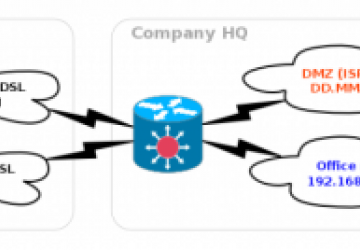
For years, we used to have a plain-old ADSL in the office—fast download speeds, slow upload, high latency—all that at the cost of $1/GB. We have had so many problems with performance and reliability that after a few years of struggling, we decided to get a second upstream link—SHDSL 5M/5M symmetric link—low latency, consistent speed during the day. It's simply awesome.
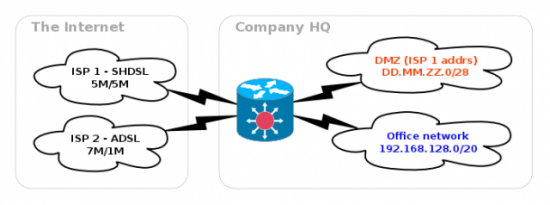
Figure 1. Network Overview
However, SHDSL is expensive! Although national traffic is free of charge, international traffic is $5/GB. Compare that with ADSL at $1/GB for both national and international (Table 1).
| ADSL | SHDSL | |
|---|---|---|
| Speed | 7M down/1M up | 5M down/5M up |
| Price national | $1/GB | Free |
| Price international | $1/GB | $5/GB |
| Public IP addresses | 1 | 1 + /28 |
There are clear pros and cons to both. That made me think (and I don't do that often), what if we kept ADSL for international traffic that's not that critical for us, and use SHDSL primarily for national traffic—fast and cheap?
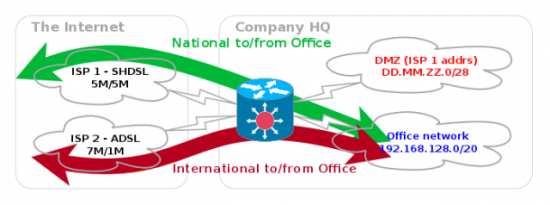
Figure 2. Split Traffic between International and National
We also got a /28 subnet with the SHDSL to use for a DMZ, and obviously, we want all the traffic to and from the DMZ to go via the SHDSL link, regardless of whether it's national or international.
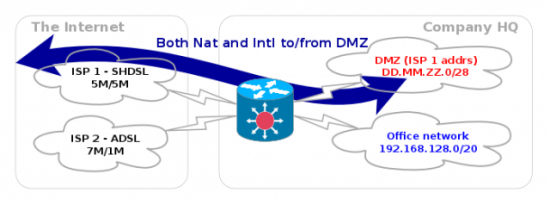
Figure 3. Traffic to/from the DMZ
Routing 101
For my plan to work, the company core router needs some way to tell whether a packet from a workstation in the office to an IP.AD.DR.ES in the wild open Internet is international or national and send it accordingly through ADSL or SHDSL. Routers use their routing tables for deciding the fates and paths of the packets they forward. A simple routing table for an office workstation with an address of 192.168.130.100 may look like this:
[workstation] ~ # ip route show
192.168.130.0/24 dev eth0 proto kernel scope link
↪src 192.168.130.100
default via 192.168.130.1 dev eth0
This says that all traffic to all other addresses in the 192.168.130.0/24 range is to be sent straight to the local network segment attached to interface eth0. All other traffic follows the "default" route and is handed over to the router with IP 192.168.130.1 to handle it. Let's assume we're sending a packet to 8.8.4.4, Google's public DNS server. For starters, we're trying to "ping 8.8.4.4" and are observing the traffic on the workstation's eth0 interface with tcpdump:
[workstation] ~ # tcpdump -i eth0 -n -s0 -e
listening on eth0, link-type EN10MB (Ethernet),
↪capture size 65535 bytes
[1] 17:53:59.615650 00:16:17:ec:5c:6c > ff:ff:ff:ff:ff:ff,
↪ethertype ARP (0x0806), length 42:
Request who-has 192.168.130.1 tell 192.168.130.100,
↪length 28
[2] 17:53:59.615775 00:14:c2:5b:4f:2c > 00:16:17:ec:5c:6c,
↪ethertype ARP (0x0806), length 60:
Reply 192.168.130.1 is-at 00:14:c2:5b:4f:2c, length 46
[3] 17:53:59.615796 00:16:17:ec:5c:6c > 00:14:c2:5b:4f:2c,
↪ethertype IPv4 (0x0800), length 98:
192.168.130.100 > 8.8.4.4: ICMP echo request,
↪id 3082, seq 1, length 64
My workstation consulted the routing table for the destination IP 8.8.4.4 and realized it should send the packet to the default router 192.168.130.1. For that, it needs the router's low-level Ethernet address (also known as a MAC address), and the first packet in the above tcpdump output, marked [1], is doing exactly that—asking for the MAC address of IP 192.168.130.1 by "broadcasting" the request to all nodes on the network segment. The second packet, marked [2], is a reply—IP 192.168.130.1 is at MAC address 00:14:c2:5b:4f:2c. Finally, the PING packet can be dispatched, with the destination IP 8.8.4.4 to the router's MAC address 00:14:c2:5b:4f:2c (see the line marked [3]).
All good, so now we can assume our router got the packet and will forward it further toward the destination. Let's see what happens on the router.
We've got both the ADSL and the SHDSL links configured, but all traffic is, by default, sent through ADSL. The ADSL modem is at 192.168.128.254. For now, the SHDSL link 203.0.113.36/30 sits idle. Here is the routing table:
[router] ~ # ip route show
[1] 203.0.113.36/30 dev vlan-shdsl proto kernel
↪scope link src 203.0.113.38
[2] 192.168.128.0/24 dev vlan-adsl proto kernel
↪scope link src 192.168.128.1
[3] 192.168.130.0/24 dev vlan-office proto kernel
↪scope link src 192.168.130.1
[4] default via 192.168.128.254 dev vlan-adsl
The first line [1] is the SHDSL link—our router's IP on that link is
203.0.113.38. The second line is the link to the ADSL modem; the third
line [3] is the network segment with my workstation, and finally, the fourth
line [4] is the default route. All packets that don't match any of the
local subnets on lines 1, 2 or 3 are sent down to the ADSL modem at
192.168.128.254 that then will forward them to the ISP 2. That's also the
fate of our packet to 8.8.4.4. Let's quickly verify what is going to
happen to it by calling ip route get:
[router] ~ # ip route get 8.8.4.4 from 192.168.130.100
↪iif vlan-office
8.8.4.4 from 192.168.130.100 via 192.168.128.254 dev vlan-adsl
As you can see, it will be sent "via 192.168.128.254", which is the ADSL modem. A simple way to check the full network path from my workstation to any given destination address is the traceroute command. It shows all the routers ("hops") along the way to the destination:
[workstation] ~ $ /usr/sbin/traceroute 8.8.4.4
traceroute to 8.8.4.4 (8.8.4.4), 30 hops max,
↪40 byte packets using UDP
1 gw-vlan-office.e-it.co.nz (192.168.130.1)
↪0.156 ms 0.126 ms 0.124 ms
2 gw-vlan-adsl.e-it.co.nz (192.168.128.254)
↪0.853 ms 0.831 ms 0.830 ms
3 core-adsl.isp2 (218.101.x.y)
↪11.765 ms 19.173 ms 19.066 ms
4 core-xyz.isp2 (203.98.x.y)
↪16.052 ms 15.515 ms 17.153 ms
[... some more hops ...]
13 64.233.x.y (64.233.x.y) 193.826 ms 194.230 ms 194.412 ms
14 * * *
15 google-public-dns-b.google.com (8.8.4.4)
↪196.086 ms 195.909 ms 195.816 ms
As you can see, the first hop is our router 192.168.130.1. The second hop is the ADSL modem 192.168.128.254. The third hop is one of the ISP2's core routers, and so on and on, passing 11 more routers before the packet finally reaches the destination 8.8.4.4, aka google-public-dns-b.google.com.
National vs. International Traffic
Google's public DNS server B is clearly an off-shore international destination. However, one of the root DNS servers, namely f.root-servers.net with IP 192.5.5.241, is present here in New Zealand. At the moment, the traceroute to f.root-servers.net still shows the ADSL path:
[workstation] ~ $ /usr/sbin/traceroute f.root-servers.net
traceroute to f.root-servers.net (192.5.5.241), 30 hops max,
↪40 byte packets using UDP
1 gw-vlan-office.e-it.co.nz (192.168.130.1)
↪0.175 ms 0.126 ms 0.125 ms
2 gw-vlan-adsl.e-it.co.nz (192.168.128.254)
↪0.861 ms 0.840 ms 0.825 ms
3 core-adsl.isp2 (218.101.x.y) 22.456 ms 22.298 ms 23.501 ms
4 isp2.ape.net.nz (192.203.154.x) 21.035 ms 20.928 ms 21.268 ms
5 isc2.ape.net.nz (192.203.154.y) 20.689 ms 21.724 ms 24.187 ms
6 f.root-servers.net (192.5.5.241) 26.680 ms 26.059 ms 25.427 ms
This is clearly national traffic, and it should go out via the SHDSL link as per our plan. We can do that manually and set the appropriate route on our core router:
[router] ~ # ip route add 192.5.5.241 via 203.0.113.37
↪dev vlan-shdsl
A side note about NAT'ing: we also need to translate (or "masquerade" or NAT) the office address range 192.168.130.0/24 to our SHDSL public IP 203.0.113.38. If we didn't, the packet's source IP would be 192.168.130.100, and the replies would never find their way back to my workstation, as this address range is not routable in the public Internet. Discussing firewalls and NATs is out of scope of this article, but to get you going, here's the simplest magic command:
[router] ~ # iptables -t nat -A POSTROUTING -s 192.168.128.0/20
↪-o vlan-shdsl -j DNAT --to 203.0.113.38
All packets with a source address from the 192.168.128.0/20 range leaving through the interface vlan-shdsl will get the source rewritten to 203.0.113.38. We didn't need to set up any masquerading for the ADSL path, because there the ADSL router NATs all our outgoing traffic.
Now, let's check the new network path:
[workstation] ~ $ /usr/sbin/traceroute f.root-servers.net
traceroute to f.root-servers.net (192.5.5.241), 30 hops max,
↪40 byte packets using UDP
1 gw-vlan-office.e-it.co.nz (192.168.130.1)
↪0.190 ms 0.129 ms 0.125 ms
2 rt-shdsl.isp1 (203.0.113.37) 2.676 ms 2.599 ms 2.632 ms
3 rt3.isp1 (121.98.ab.cd) 2.715 ms 2.680 ms 2.591 ms
4 isc2.ape.net.nz (192.203.154.z) 2.919 ms 3.033 ms 3.088 ms
5 f.root-servers.net (192.5.5.241) 3.007 ms 2.670 ms 2.864 ms
That's lot better. The first hop remains the same, that's my workstation's router, but the second hop is no longer the ADSL modem. Instead, it's the SHDSL ISP1's core router. It also clearly shows the latency improvement—from 26ms over ADSL to 3ms over SHDSL.
Let's remove the manual route again to avoid any confusion down the road and query the routing table:
[router] ~ # ip route get 192.5.5.241 from
↪192.168.130.100 iif vlan-office
192.5.5.241 from 192.168.130.100 via 203.0.113.37
↪dev vlan-shdsl # SHDSL
[router] ~ # ip route delete 192.5.5.241 via 203.0.113.37
↪dev vlan-shdsl
[router] ~ # ip route get 192.5.5.241 from
↪192.168.130.100 iif vlan-office
192.5.5.241 from 192.168.130.100 via 192.168.128.254
↪dev vlan-adsl # ADSL
So all we need now is a list of all national IP addresses, put them in the routing table, and we're done. But how? Manually? Even in a small country like New Zealand there are hundreds of local IP addresses and prefixes, and the list is dynamic and changes daily. There is no way such a list could be managed manually. We need a better tool.
Feeding the Bird
BGP is the routing protocol of today's Internet. Each and every ISP on the planet tells all other ISPs on the planet what IP addresses it has in its network and what other IP addresses can be reached through that ISP's network. The protocol to exchange this kind of information is called BGP (Border Gateway Protocol).
I'm not going to dive in to the details of BGP. All we need to know is that our ISP1 can use BGP to send us the list of all the national prefixes. Instead of entering them manually, we will listen to the "BGP feed" and update our routing table from it. This part needs coordination with the Internet provider, so I asked our ISP1 to "please assign us a private ASN and send us a BGP feed with national prefixes". BGP usually runs between Autonomous Systems identified by ASN (Autonomous System Number). Any big enough organization can apply and pay for its own official ASN, but for our purpose, it's enough to use an ASN from a private range assigned by the ISP. Table 2 shows the information I received from them.
| ISP | Company | |
|---|---|---|
| ASN | 177XY | 6452X |
| Router IP | 203.0.113.37 | 203.0.113.38 |
| Prefixes advertised | all national ones | none |
Now we have the routers' IPs on both sides of the link, both ASNs and confirmation of what prefixes they will send us ("all national ones"). That's all the info we need.
A number of BGP dæmons are available for Linux. I chose Bird (at the time, the most recent version was 1.3.4) and installed it from an RPM.
Bird's configuration is very simple. The config file is at /etc/bird/bird.conf and may look like this:
log syslog all;
protocol kernel {
import none;
export all;
}
protocol device {
scan time 10;
}
protocol bgp {
description "ISP1 National Routes";
local as 64526;
neighbor 203.0.113.37 as 17746;
source address 203.0.113.38;
import all; # Accept all prefixes from our neighbor
export none; # Don't send the neighbor any prefixes
}
Essentially, the Bird process talks to the BGP neighbor and imports all the advertised prefixes into its internal routes list. It also talks with the kernel and "exports to the kernel" all the routes it knows—that is, all the ones learned over BGP. That way, it feeds the kernel routing table from the BGP.
With the BGP routes imported, the kernel routing table now has more than 4,000 records:
[router] ~ # ip route show
[1] 203.0.113.36/30 dev vlan-shdsl proto kernel
↪scope link src 203.0.113.38
[2] 192.168.128.0/24 dev vlan-adsl proto kernel
↪scope link src 192.168.128.1
[3] 192.168.130.0/24 dev vlan-office proto kernel
↪scope link src 192.168.130.1
[4] default via 192.168.128.254 dev vlan-adsl
[5] 14.1.32.0/19 via 203.0.113.37 dev vlan-shdsl proto bird
[6] 27.252.0.0/16 via 203.0.113.37 dev vlan-shdsl proto bird
[7] 58.28.0.0/16 via 203.0.113.37 dev vlan-shdsl proto bird
....
[4509] 203.97.0.0/17 via 203.0.113.37 dev vlan-shdsl proto bird
[4510] 222.153.128.0/18 via 203.0.113.37 dev vlan-shdsl proto bird
[4511] 222.155.96.0/19 via 203.0.113.37 dev vlan-shdsl proto bird
Lines [1] to [4] are the same that you've seen before—all of the directly connected subnets and the default route. Lines [5] to [4511] are the routes received over BGP.
Now, let's query the newly populated routing for a path to our favourite f.root-servers.net:
[router] ~ # ip route get 192.5.5.241 from
↪192.168.130.100 iif vlan-office
192.5.5.241 from 192.168.130.100 via
↪203.0.113.37 dev vlan-shdsl # SHDSL
Excellent, that's what we wanted! A couple traceroute runs from the workstation to both national and international destinations verifies that the new path is used as expected.
The DMZ Challenge
One of the requirements for our second Internet link was the possibility to get a block of public IP addresses for our DMZ (DeMilitarized Zone) where we plan to host some externally accessible services. From the ISP, we got block 203.0.113.208/28, and we want all the traffic to and from the DMZ to use the SHDSL link, regardless of whether it's national or international traffic. Routing the inbound traffic is the ISP's responsibility, but outbound is our job.
Let's see what happens with our current setup. On a test DMZ box, 203.0.113.222, the routing table looks like this:
[dmz-box] ~ # ip route show
203.0.113.208/28 dev eth0 proto kernel
↪scope link src 203.0.113.222
default via 203.0.113.209 dev eth0
All the traffic goes to the router's IP 203.0.113.209, and the router then decides what to do. Let's traceroute to the Google's public DNS server again and see how it goes:
[dmz-box] ~ # traceroute 8.8.4.4
traceroute to 8.8.4.4 (8.8.4.4), 30 hops max, 60 byte packets
1 gw-dmz.e-it.co.nz (203.0.113.209) 0.175 ms 0.110 ms 0.110 ms
2 gw-vlan-adsl.e-it.co.nz (192.168.128.254)
↪8.707 ms 9.080 ms 9.522 ms
3 core-adsl.isp2 (218.101.x.y) 11.899 ms 13.555 ms 15.585 ms
4 core-xyz.isp2 (203.98.x.y) 15.114 ms 16.332 ms 17.142 ms
[... some more hops ...]
13 64.233.x.y (64.233.x.y) 195.061 ms 198.098 ms 197.589 ms
14 * * *
15 google-public-dns-b.google.com (8.8.4.4)
↪203.621 ms 204.588 ms 205.792 ms
That's not quite what we wanted. The traffic flows through the ADSL link instead of the SHDSL link. But, it's understandable. Our router selects the network paths based only on the destination IP, disregarding the source IP. As soon as it sees a packet for 8.8.4.4, it sends it down the ADSL path, regardless of whether it comes from my workstation at 192.168.130.100 or from the DMZ box at 203.0.113.222.
Fortunately, the Linux kernel can have up to 255 independent routing tables and up to 32,768 different rules specifying which routing table to look up for each packet. The standard ruleset on a recent Linux machine looks like this:
[router] ~ # ip rule show
0: from all lookup local
32766: from all lookup main
32767: from all lookup default
There are no constraints for the rules. All three rules may be consulted for packets "from all" addresses until a matching route is found. According to the rules, the "local" table is looked up first. The "local" table is maintained by the kernel and contains rules for broadcast addresses and similar special destinations. You can list its contents, but unless you know exactly what you're doing, you better not change it:
[router] ~ # ip route show table local
broadcast 192.168.130.0 dev vlan-office proto kernel
↪scope link src 192.168.130.1
local 192.168.130.1 dev vlan-office proto kernel
↪scope host src 192.168.130.1
local 203.0.113.38 dev vlan-shdsl proto kernel
↪scope host src 203.0.113.38
broadcast 203.0.113.39 dev vlan-shdsl proto kernel
↪scope link src 203.0.113.38
broadcast 127.0.0.0 dev lo proto kernel
↪scope link src 127.0.0.1
local 127.0.0.1 dev lo proto kernel scope host src 127.0.0.1
[... a lot more routes ...]
If no match is found in the "local" table, the kernel moves on the the next
rule that says "lookup main". The "main" table is the standard table where
all the "normal" routes end up—all the routes for directly connected
subnets, manually added static routes and also the routes from BGP. The
command ip route show works by default with the
"main" table and is
equivalent to ip route show table main. If still no match
is found, the
last rule says "lookup default". The "default" table is seldom used and is
usually empty.
In fact, the kernel tables have numerical IDs, and the words "main", "local" and "default" are just convenient verbose names defined in /etc/iproute2/rt_tables:
[router] ~ # cat /etc/iproute2/rt_tables
#
# reserved values
#
255 local
254 main
253 default
0 unspec
So, to recap our current situation, we've got the "main" table with a list of all national routes for SHDSL and one default route for ADSL for all international traffic. And, we've got a default rule that says "for all source addresses consult the main table".
Solving the DMZ Challenge
What we need now is to set up a special routing table for all DMZ traffic and create a rule that will plug it in to the routing decision process.
The first step is to create and populate the new table and name it "dmz". We can choose any non-reserved table ID and add one line into the rt_table file to map the ID to our desired name:
[router] ~ # echo "121 dmz" >> /etc/iproute2/rt_tables
[router] ~ # ip route show table dmz
[router] ~ #
The dmz table is empty for now. Let's populate it. Apparently, we need just the default route—everything should be sent to ISP1's gateway:
[router] ~ # ip route add default via 203.0.113.37
↪dev vlan-shdsl table dmz
[router] ~ # ip route show table dmz
default via 203.0.113.37 dev vlan-shdsl
All we need to do now is activate the table by adding a lookup rule to the routing decision process. The lookup rules can be based on many different parameters—the source and/or destination address or address range, the incoming interface, the TOS (Type Of Service) or an arbitrary "fwmark" value that is used in conjunction with iptables rules. For our purpose, the source IP and incoming network interface are the "selectors" that we need:
[router] ~ # ip rule add pri 1000 from 203.0.113.208/28
↪iif vlan-dmz lookup dmz
[router] ~ # ip rule show
0: from all lookup local
1000: from 203.0.113.208/28 iif vlan-dmz lookup dmz
32766: from all lookup main
32767: from all lookup default
All the packets coming from interface vlan-dmz with source address 203.0.113.208/28 will consult the dmz table. And the dmz table says to send them all to the SHDSL link by default. Let's see if it works:
[dmz-box] ~ # traceroute 8.8.4.4
traceroute to 8.8.4.4 (8.8.4.4), 30 hops max, 60 byte packets
1 gw-dmz.e-it.co.nz (203.0.113.209)
↪0.200 ms 0.124 ms 0.110 ms
2 rt-shdsl.isp1 (203.0.113.37) 2.676 ms 2.599 ms 2.632 ms
3 rt3.isp1 (121.98.ab.cd) 2.715 ms 2.680 ms 2.591 ms
[... some more hops ...]
10 216.239.xx.yy (216.239.xx.yy)
↪172.955 ms 172.398 ms 172.339 ms
11 * * *
12 google-public-dns-b.google.com (8.8.4.4)
↪171.703 ms 171.621 ms 170.554 ms
That looks good. The international traffic from the box in DMZ goes over the SHDSL link, while at the same time, we can re-check that from the workstation in the internal LAN, it still goes over ADSL:
[workstation] ~ # traceroute 8.8.4.4
traceroute to 8.8.4.4 (8.8.4.4), 30 hops max,
↪40 byte packets using UDP
1 gw-vlan-office.e-it.co.nz (192.168.130.1)
↪0.170 ms 0.128 ms 0.125 ms
2 gw-vlan-adsl.e-it.co.nz (192.168.128.254)
↪0.861 ms 0.846 ms 0.825 ms
3 core-adsl.isp2 (218.101.x.y) 22.718 ms 22.109 ms 21.931 ms
4 core-xyz.isp2 (203.98.x.y) 20.417 ms 20.222 ms 19.769 ms
[... some more hops ...]
13 64.233.x.y (64.233.x.y) 198.456 ms 197.824 ms 197.189 ms
14 * * *
15 google-public-dns-b.google.com (8.8.4.4)
↪194.318 ms 194.153 ms 194.159 ms
Magic, isn't it! It all looks good, and we're done, right? Well, not quite.
More Work for DMZ Routing
What happens when pinging the DMZ box from my workstation? First, the ping packet goes from 192.168.130.100 to the router. The router consults the "main" routing table, sees that the destination 203.0.113.222 is on a directly connected vlan-dmz and sends the ping request there. The DMZ box replies with a packet from 203.0.113.222 to 192.168.130.100—that's my workstation on vlan-office—and sends it to the router. The router sees that it arrived from the DMZ address range and consults the "dmz" table! The only record in there is the default route, so it takes it and dispatches the packet with destination IP 192.168.130.100 to the ISP where it eventually gets discarded. Oops!
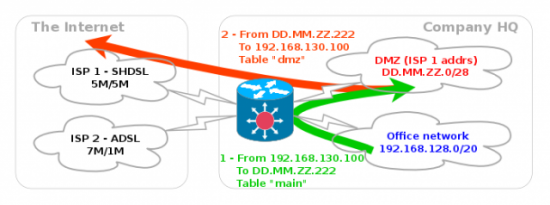
Figure 4. Broken Traffic between DMZ and the Office
There are a number of solutions. Either we can copy all the non-BGP routes from the "main" table to the "dmz" table—that's indeed possible but not very elegant. A better option is to add a new routing entry to the "dmz" table that, when matched, will make the kernel move on to the next rule on the list:
[router] ~ # ip rule show
0: from all lookup local
1000: from 203.0.113.208/28 iif vlan-dmz lookup dmz
32766: from all lookup main
32767: from all lookup default
[router] ~ # ip route add throw 192.168.128.0/20 table dmz
[router] ~ # ip route show table dmz
throw 192.168.128.0/20
default via 203.0.113.37 dev vlan-shdsl
What happens now with the ping reply packet is this: the kernel sees a matching rule 1000 and looks up the "dmz" table. There it finds that the best matching route for a destination of 192.168.130.100 is "throw". That tells it to choose the next available rule—in our case, "32766: from all lookup main" and looks up the "main" table. Here it finds a path to the 192.168.130.0/24 subnet and sends the ping reply to vlan-office. Problem fixed.
Another way, equally as good if not even better, is to go straight to the "main" table for all packets that arrive from the DMZ and are destined for our company's internal address range. Let's add a rule for it:
[router] ~ # ip rule add pri 999 from 203.0.113.208/28
↪iif vlan-dmz to 192.168.128.0/20 table main
[router] ~ # ip rule show
0: from all lookup local
999: from 203.0.113.208/28 to 192.168.128.0/20
↪iif vlan-dmz lookup main
1000: from 203.0.113.208/28 iif vlan-dmz lookup dmz
32766: from all lookup main
32767: from all lookup default
With this rule in place, the router will see that the ping reply packet matches the rule "from 203.0.113.208/28 to 192.168.128.0/20" and will look up the "main" table instead of the "dmz" table right away. Personally, I like this solution the most as it explicitly says "lookup main" instead of a more vague "go to the next rule", whatever it may be, that the former solution does.
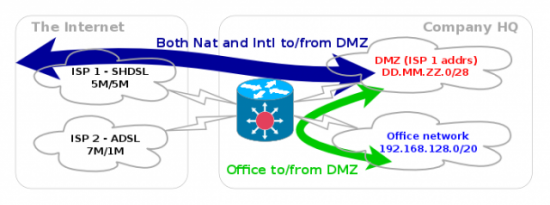
Figure 5. DMZ traffic works as expected.
Making the Changes Permanent
Many of the changes we have done so far are only in the router's memory and will disappear after a reboot. Let's make them permanent. Our core router is CentOS 6.2, and the following steps should work on any recent Red Hat Enterprise Linux or Fedora-based system.
A permanent name already has been given to the "dmz" table:
[router] ~ # cat /etc/iproute2/rt_tables
# reserved values
255 local
254 main
253 default
0 unspec
# local
121 dmz
To add the new ip rules, edit the file /etc/sysconfig/network-scripts/rule-<interface>. As soon as the given interface is configured, the rules will be loaded. The logical place is to load our rules once the DMZ interface vlan-dmz is configured:
[router] ~ # cat /etc/sysconfig/network-scripts/rule-vlan-dmz
# ip rule add ...
pri 999 from 203.0.113.208/28 to 192.168.128.0/20
↪iif vlan-dmz lookup main
pri 1000 from 203.0.113.208/28 iif vlan-dmz lookup dmz
Finally, populate the "dmz" table on reboot. This is done in the route-<interface> file in the same directory:
[router] ~ # cat /etc/sysconfig/network-scripts/route-vlan-dmz
# ip route add ...
default via 203.0.113.37 dev vlan-shdsl table dmz
# throw 192.168.128.0/20 table dmz ## unless the rule 999 is in place
That's it. The routing now works as designed and survives a reboot.
Networking 201?
The topics I explained in this article—multiple routing tables, rules for selecting them and a hint of BGP—should give you enough knowledge to build moderately complex Linux-based routers. In this trade, you will come across a lot more concepts—from OSPF through firewalls and NATs to VPNs and high-availability networks. None of these topics are within the scope of this article; however, in the end, the core thing that makes all this networking fun possible is routing. If you learn the few simple concepts of how IP routing works, you will know half of what networking is all about. Happy experimenting!









